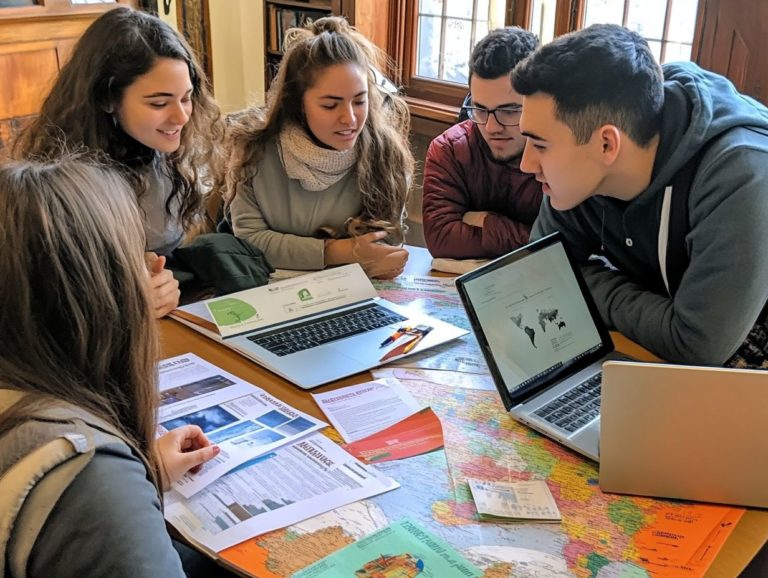The Future of Scholarships: Trends to Watch
Navigating the world of scholarships can feel both exhilarating and overwhelming. With various funding options at your fingertips, understanding the current landscape is crucial for you and your family.
Get ready to explore the exciting world of scholarships! This article dives into the types of scholarships available, the challenges you may face, and how technology is transforming education funding. You’ll discover emerging non-traditional scholarships, key trends in eligibility criteria, and a growing focus on diversity and inclusion.
Join us as we unpack the future of scholarships and what it means for aspiring scholars like you.
Contents
- Key Takeaways:
- The Current State of Scholarships
- Technological Advancements and Scholarships
- The Rise of Non-Traditional Scholarships
- Scholarship Trends to Watch
- Frequently Asked Questions
- What are some trends to watch for in the future of scholarships?
- Will scholarships become more competitive in the future?
- How will technology impact the future of scholarships?
- Will there be a shift towards need-based scholarships in the future?
- What impact will changing demographics have on scholarships in the future?
- How can I stay updated on the latest trends in the future of scholarships?
Key Takeaways:

- Scholarships are evolving with technology, making applications more efficient.
- Non-traditional scholarships offer new funding opportunities for students.
- Future trends include shifts in eligibility and a focus on diversity.
The Current State of Scholarships
The current landscape of scholarships presents a complex interplay of factors, including rising college costs, an evolving scholarship application process, and a growing emphasis on equity in education.
Institutions such as Georgetown University and organizations like InsideTrack recognize the significance of educational investments that promote economic mobility and alleviate student loan debt.
As this landscape evolves, grasping these elements is essential as you navigate your educational journey.
Types of Scholarships Available
You ll find a variety of scholarships today, from skills-based options to corporate-sponsored ones, all designed to enhance your career prospects and support your educational journey. Prestigious institutions like Harvard, Stanford, and UCLA lead the way in offering diverse funding options that also consider your mental health and wellbeing.
Merit-based scholarships reward exceptional academic achievements, while need-based scholarships aim to support students from low-income families, reflecting a growing trend toward inclusivity in higher education. Many organizations have introduced goal-oriented scholarships that encourage you to pursue specific fields, such as science, technology, engineering, and mathematics (STEM) or the arts, aligning financial support with societal needs.
As mental health gains importance, certain institutions now offer specialized scholarships focusing on psychological and emotional support, recognizing that your wellbeing is essential for academic success. These evolving scholarship opportunities showcase a broader commitment to creating equitable pathways for all students, ultimately enhancing your learning experiences and future career possibilities.
Challenges and Limitations
Despite the availability of scholarships, you may encounter numerous challenges and limitations. The scholarship application process can be complex, and the burden of significant student loan debt can hinder your educational attainment and equity in education. Reports from organizations like the U.S. Department of Labor and NEA Today highlight the growing issue of faculty burnout, which may indirectly impact your scholarship opportunities.
These hurdles become even more pronounced as workforce trends shift, leaving institutions to juggle limited resources alongside increasing enrollment demands. As faculty members face their own mental health struggles, the quality of mentorship and guidance available to you as a prospective applicant may diminish, leaving you unprepared to navigate the scholarship process effectively.
The emphasis on standardized testing and strict eligibility criteria can further alienate students from diverse backgrounds, stifling your aspirations amid economic challenges. As this landscape continues to evolve, it is essential for both you and educational institutions to effectively tackle these interconnected issues.
Start your scholarship journey today and seize the amazing opportunities available!
Technological Advancements and Scholarships

New technology, especially artificial intelligence (AI), is significantly transforming the scholarship landscape. It affects how education investments are made and how you navigate your educational career.
Organizations like Opportunity Insights and the Urban Institute are also leading the charge in using these technologies to streamline the scholarship application process. This enhances accessibility for underrepresented students.
How Technology is Changing the Scholarship Landscape
AI is changing the scholarship landscape in remarkable ways. It’s not just automating the scholarship application process; it also enhances the efficiency of candidate evaluations, amplifying education investments that prioritize student mental health.
Platforms such as Healthy Minds and Limeade harness these advancements to bolster mental health services alongside educational funding. Online platforms are bridging the gap between scholarship organizations and applicants, making essential resources more accessible.
AI-driven tools analyze applicant profiles to match them with scholarships that align with their needs, fostering greater equity. This ensures that underrepresented groups receive the tailored support they deserve.
This targeted assistance lightens the load of searching for opportunities, allowing students to focus on their studies and personal growth while maintaining mental health. The integration of these technological advancements cultivates a more inclusive educational environment, contributing to holistic student development.
The Rise of Non-Traditional Scholarships
Exciting new scholarship opportunities are emerging. Non-traditional scholarships signify a transformation in funding strategies, emphasizing practical experience through internships and apprenticeships. These skills-based scholarships focus on practical skills gained through work experience, aligning with current workforce trends.
This shift, guided by insights from the World Health Organization and the Education Data Initiative, seeks to enhance economic mobility and accessibility for diverse student populations.
Alternative Sources of Funding for Education
Alternative funding sources for education such as corporate-sponsored scholarships and opportunities for internships and apprenticeships are essential tools in tackling soaring college costs and enhancing economic mobility.
Many large corporations have launched scholarship programs specifically targeting underrepresented minorities. These initiatives offer not just financial support but also tailored mentorship and networking opportunities, giving recipients an edge in their academic and professional journeys.
A standout example is the Gates Millennium Scholars Program, which has enabled thousands of students to pursue their academic aspirations without the burden of student debt. Organizations like Year Up connect young adults with high-demand internships, allowing them to gain valuable work experience while earning stipends to offset living expenses.
By exploring these diverse funding avenues, educational institutions can broaden access, ensuring that economic barriers are diminished.
Scholarship Trends to Watch

Scholarship trends to watch reveal significant shifts in eligibility criteria aimed at enhancing diversity and inclusion. The influence of globalization on education funding is becoming increasingly clear.
These trends are essential for understanding how educational institutions are adapting to the changing job market. They prioritize student mental health throughout educational experiences.
Stay informed about these trends to make the best choices for your educational path!
Shifts in Eligibility Criteria
Recent shifts in scholarship eligibility criteria reflect a growing commitment to equity in education. There is a spotlight on the importance of scholarships that reward practical skills and corporate-sponsored programs that align with workforce needs.
The Education Data Initiative underscores these changes, illustrating how institutions are actively responding to diverse student populations they serve.
As these eligibility criteria evolve, they not only recognize academic achievements but also emphasize practical skills and community involvement. This opens doors for a broader range of candidates to access financial support.
This transformation holds particular significance for underrepresented groups, as it helps bridge educational disparities.
By fostering partnerships between educational institutions and industry stakeholders, scholarship programs are strategically designed to prepare students for future job markets while promoting inclusivity. With these initiatives in place, this brings exciting new opportunities for students from all backgrounds.
Increasing Diversity and Inclusion
The growing emphasis on diversity and inclusion in scholarships is transforming education funding models. This trend prompts the creation of corporate-sponsored scholarships designed to expand access for underrepresented groups.
This approach is crucial not just for enhancing educational career paths, but also for addressing the mental health services necessary to support diverse student populations.
Such initiatives can encompass targeted grants for first-generation college students, women in STEM, and scholarships for individuals from low-income backgrounds.
These programs do more than ease financial burdens; they foster a supportive network that promotes engagement and retention in educational institutions.
By integrating mentorship and resources specifically tailored to the unique challenges faced by these groups, scholarship programs nurture talent and cultivate an inclusive atmosphere. Ultimately, a more diverse educational landscape enriches the academic experience for everyone, driving innovation and understanding in today s interconnected world.
Impact of Globalization
The impact of globalization on scholarships is clear: there s a growing array of international funding opportunities and a strong emphasis on educational investments designed to enhance economic mobility for students around the globe.
As the job market continues to recover, it s essential for students to grasp these global trends, especially when navigating education financing and student loan debt.
Educational institutions are evolving their funding models to keep pace with these changes. Often, they form partnerships with global organizations to enrich their scholarship offerings.
This shift widens the spectrum of financial aid available to students and fosters greater diversity within academic settings.
As nations increasingly acknowledge the importance of developing a skilled workforce, scholarships are shifting focus toward high-demand fields that promise solid career prospects.
This means students have access to a more extensive range of options that can significantly shape their educational path and future job stability.
Frequently Asked Questions

What are some trends to watch for in the future of scholarships?
Some trends to watch for in the future of scholarships include:
- An increase in smaller, niche scholarships
- A focus on diversity and inclusion
- A rise in technology-driven scholarship applications
Will scholarships become more competitive in the future?
It is likely that scholarships will become more competitive as the demand for higher education continues to rise and tuition costs increase. Students will need to put more effort into their scholarship applications to stand out among a larger pool of applicants.
How will technology impact the future of scholarships?
Technology will play a significant role in the future of scholarships, making the application and selection process more efficient and accessible. This may include using artificial intelligence to match students with relevant scholarships or online platforms for submitting applications and supporting materials.
Will there be a shift towards need-based scholarships in the future?
There is a growing focus on need-based scholarships. This trend is likely to continue as student debt and financial struggles increase for families.
What impact will changing demographics have on scholarships in the future?
The changing demographics of students, including more non-traditional and international students, will influence scholarship types.
Expect a stronger push to support diverse students and enhance global education opportunities!
How can I stay updated on the latest trends in the future of scholarships?
Stay informed about scholarship trends by following industry news and joining online communities.
Connect with scholarship organizations or your school’s financial aid office for valuable resources.






